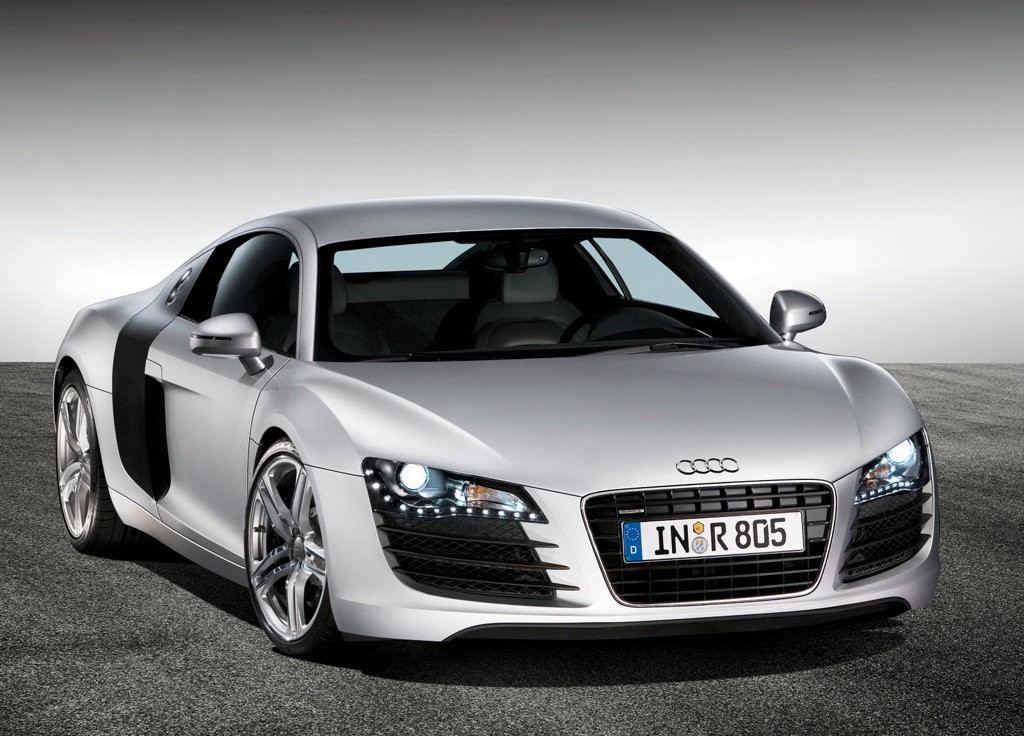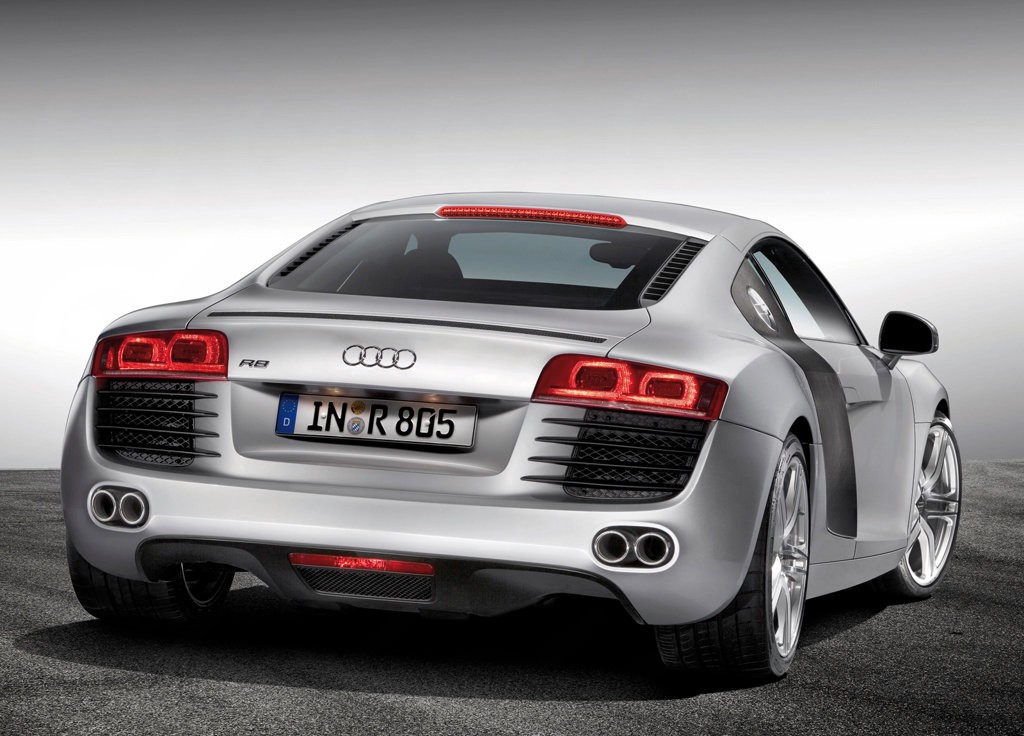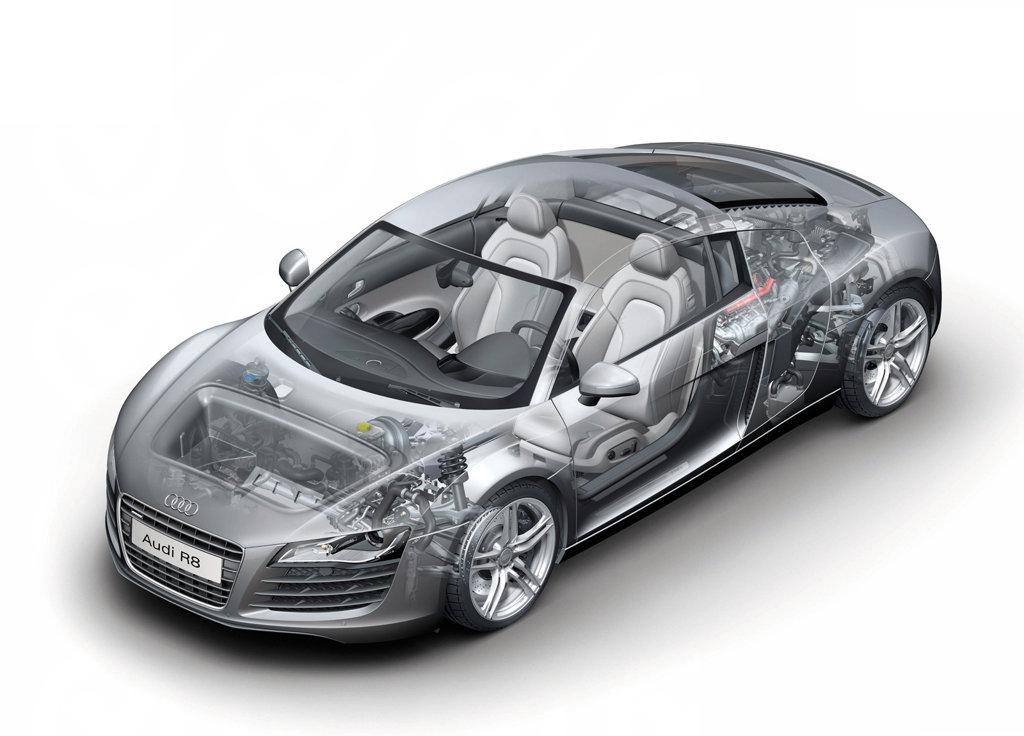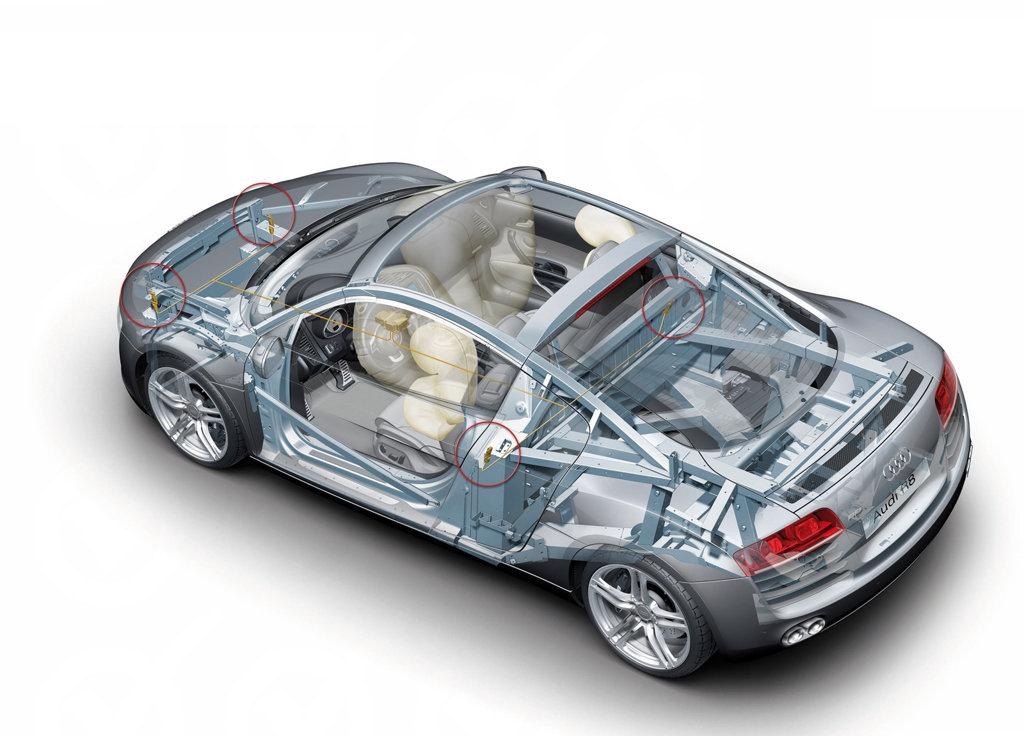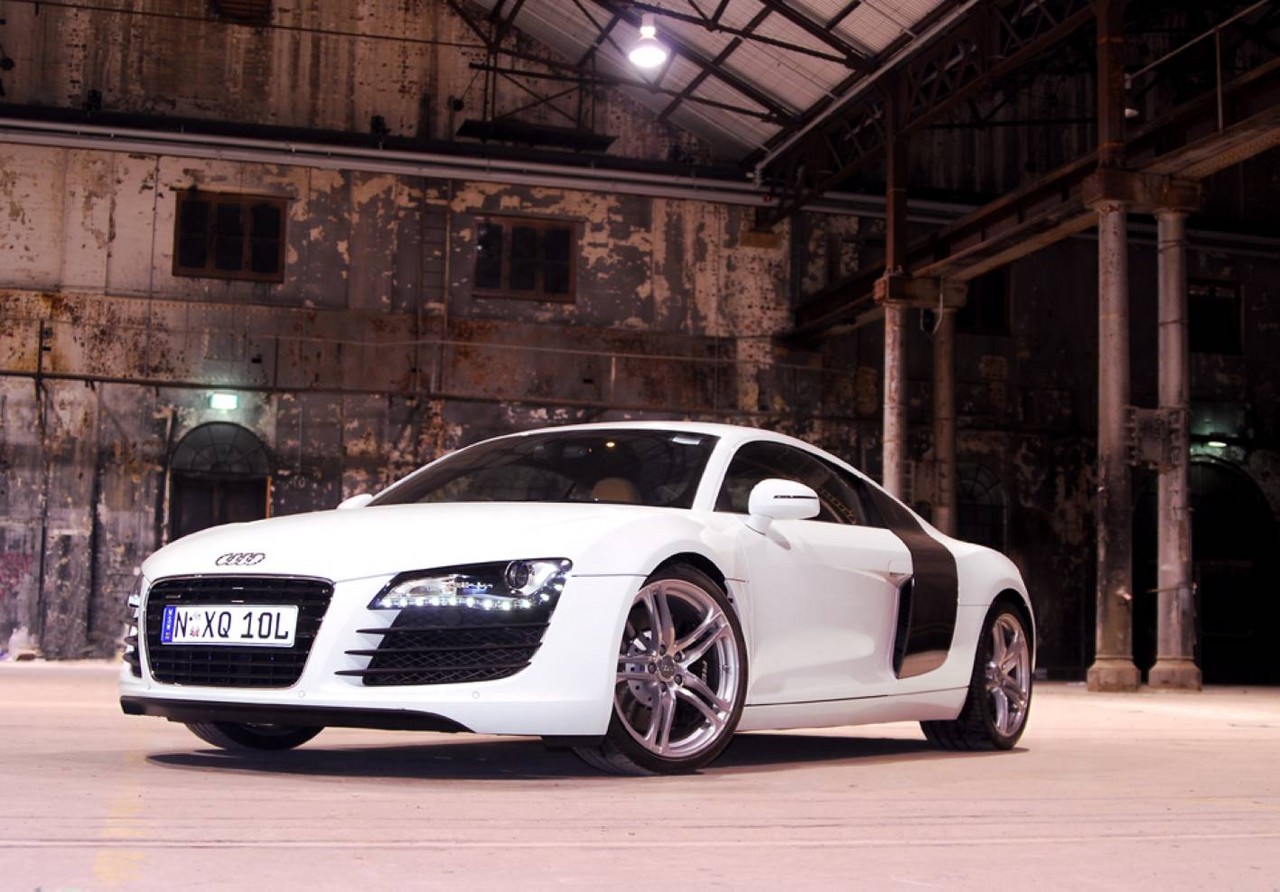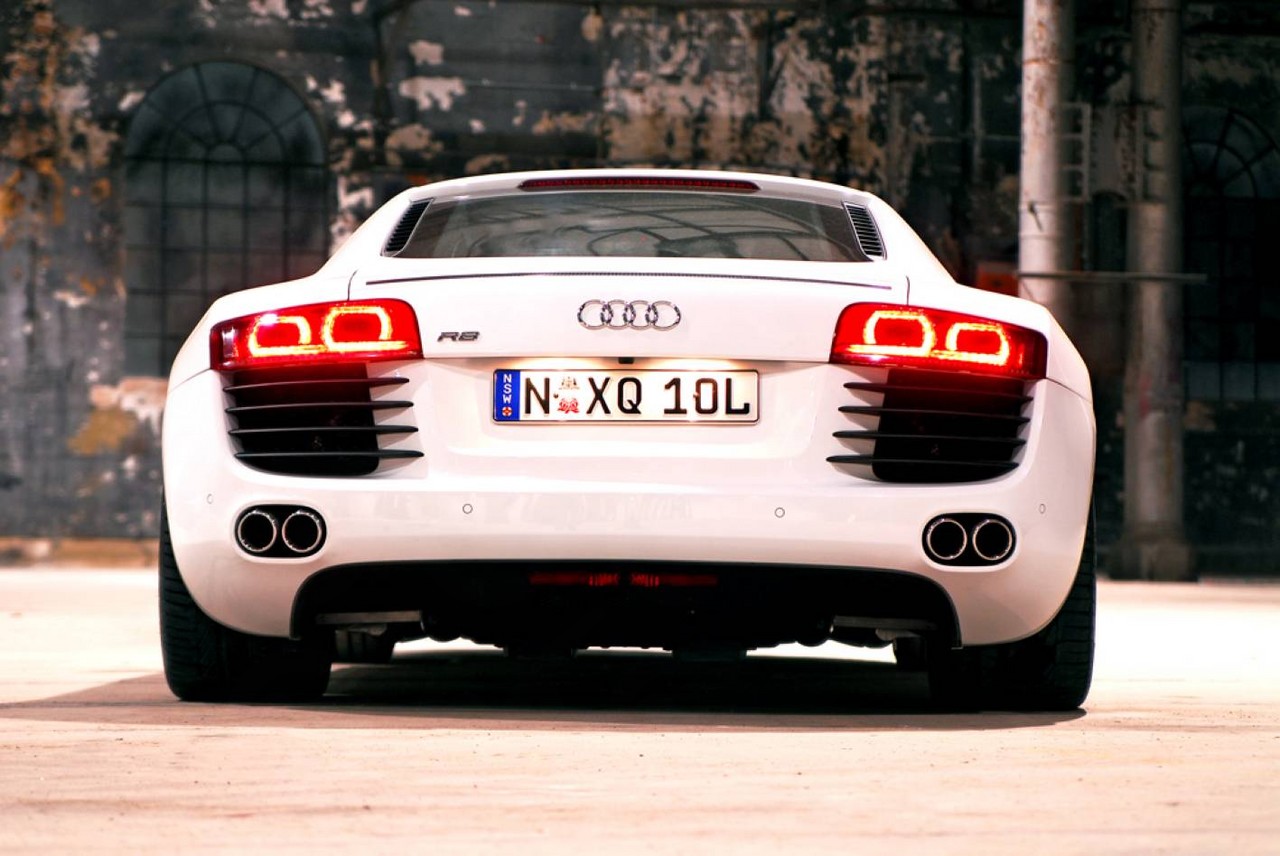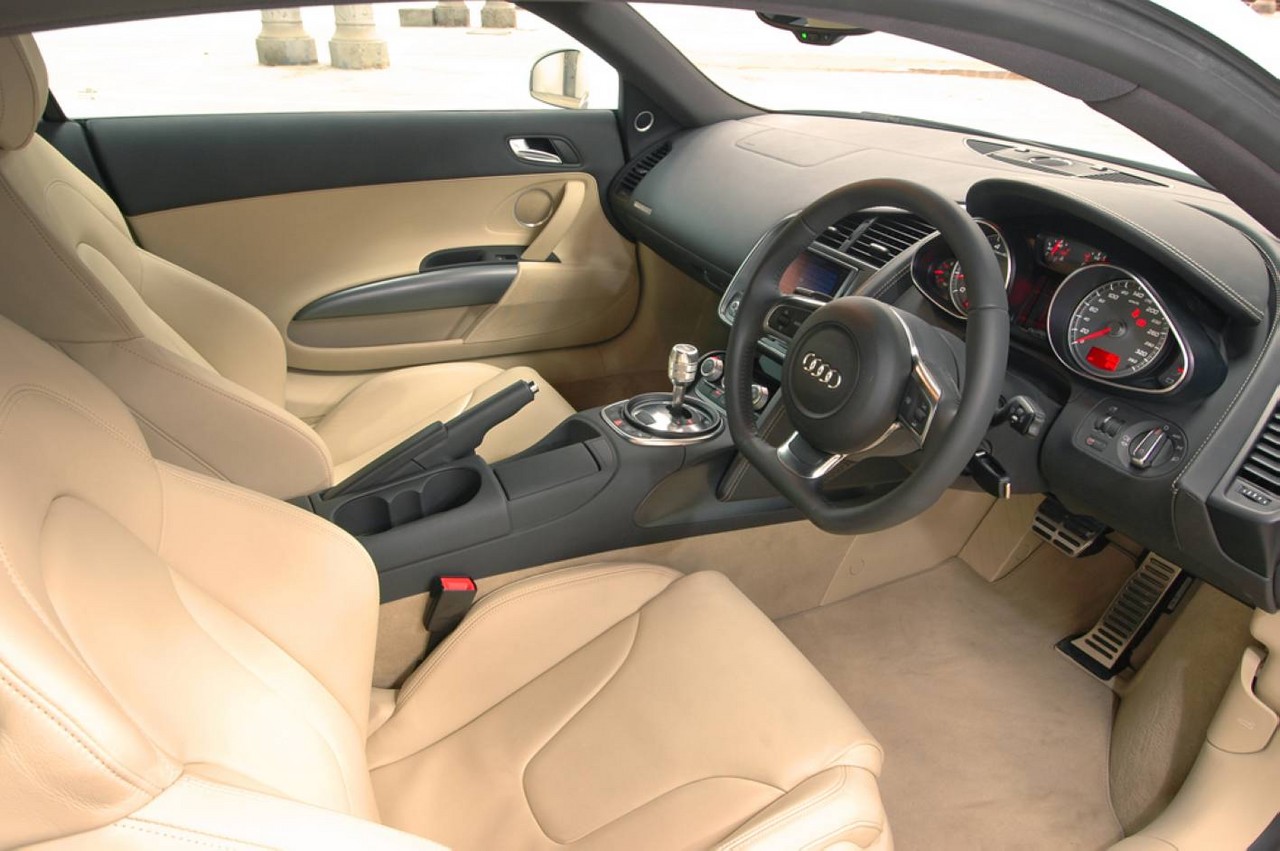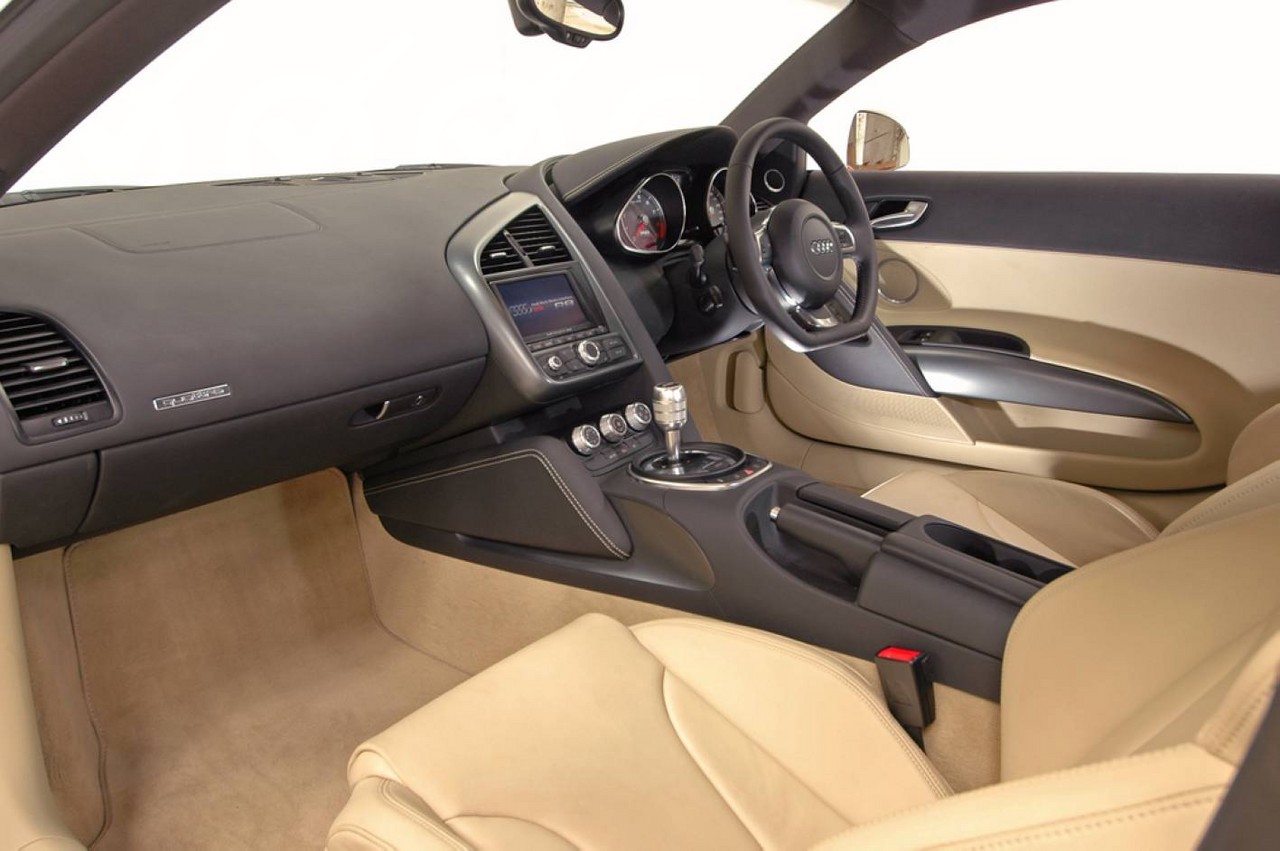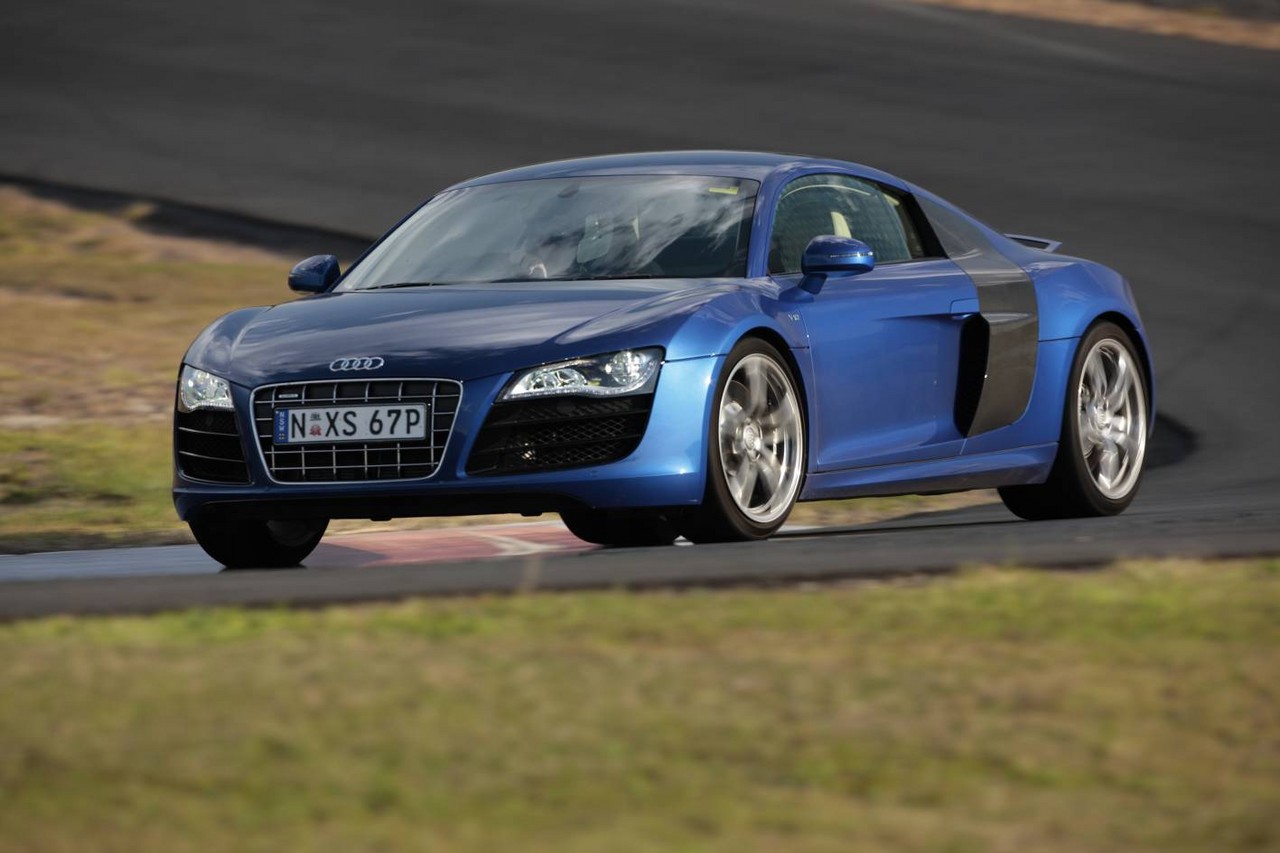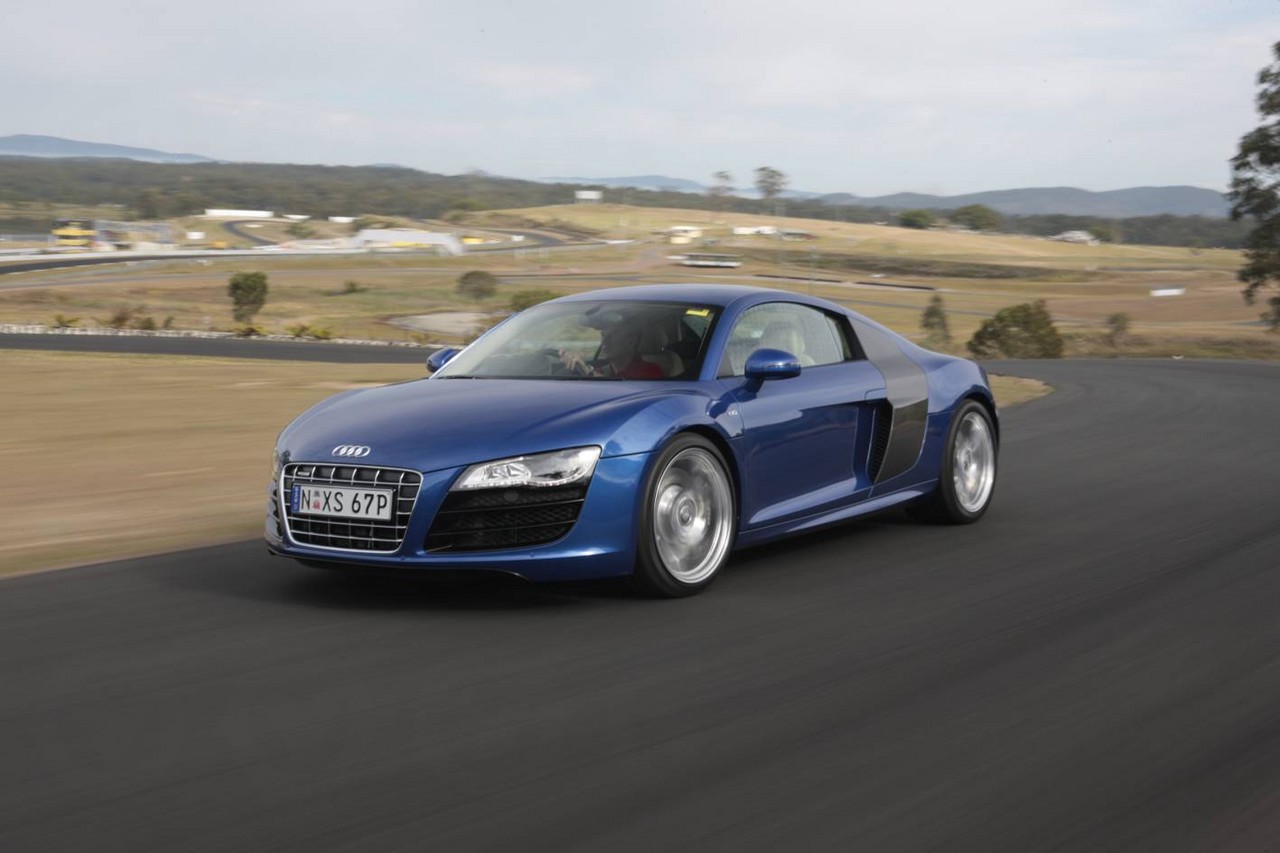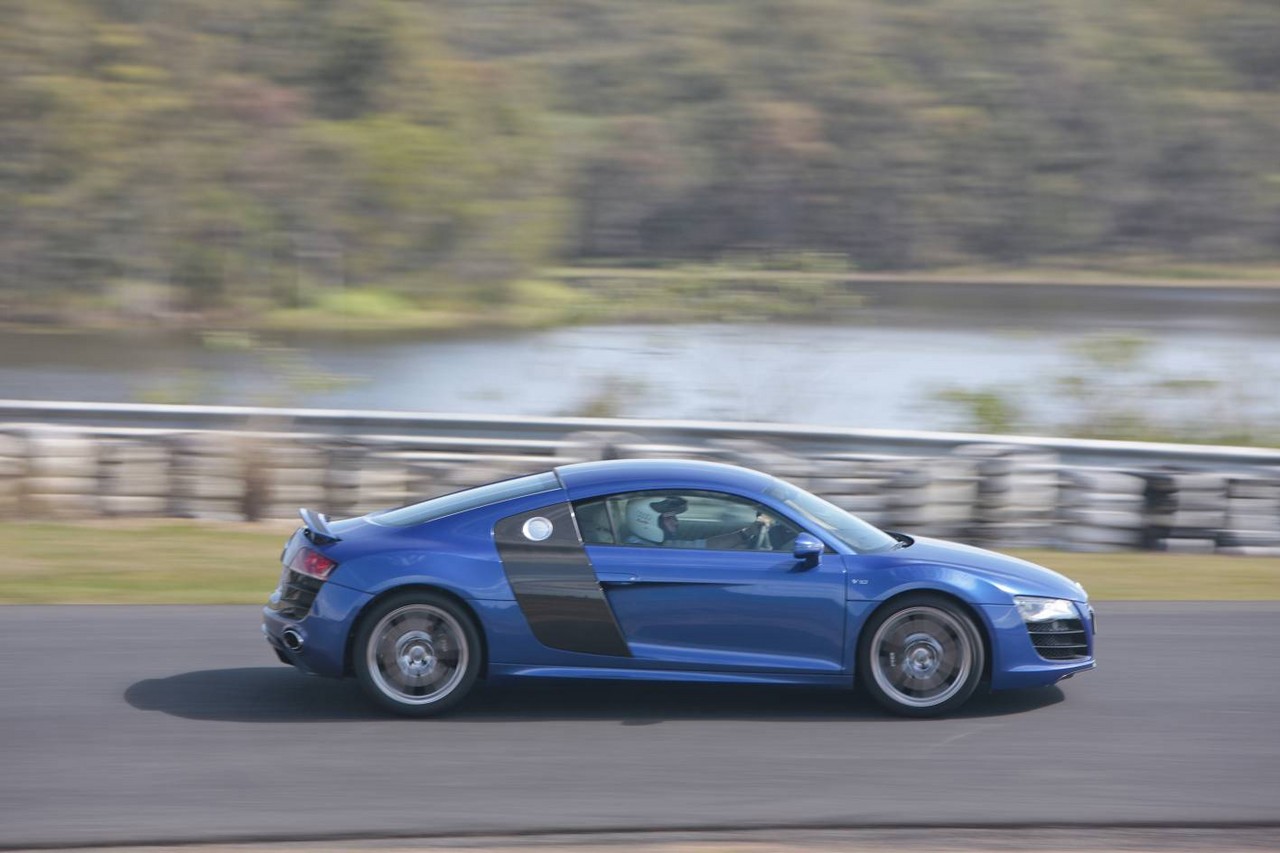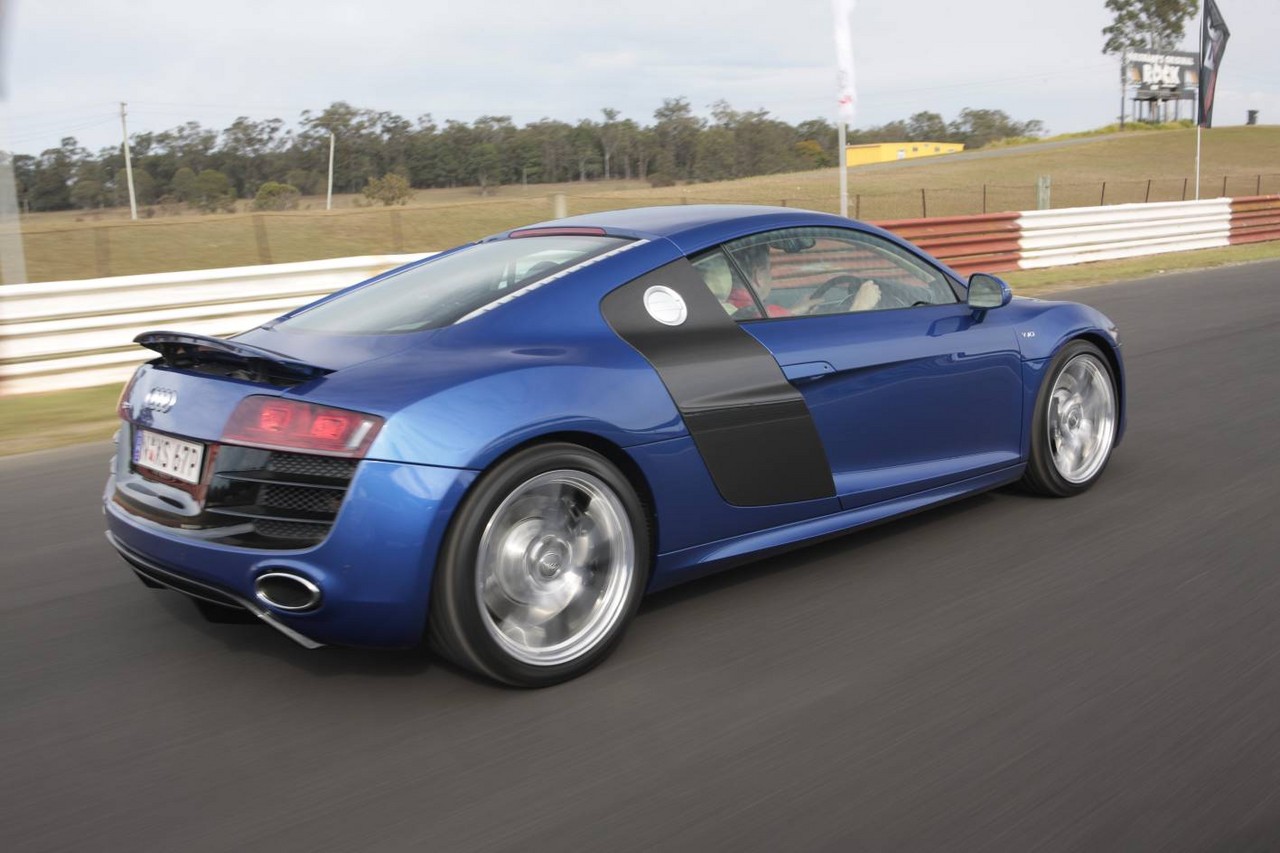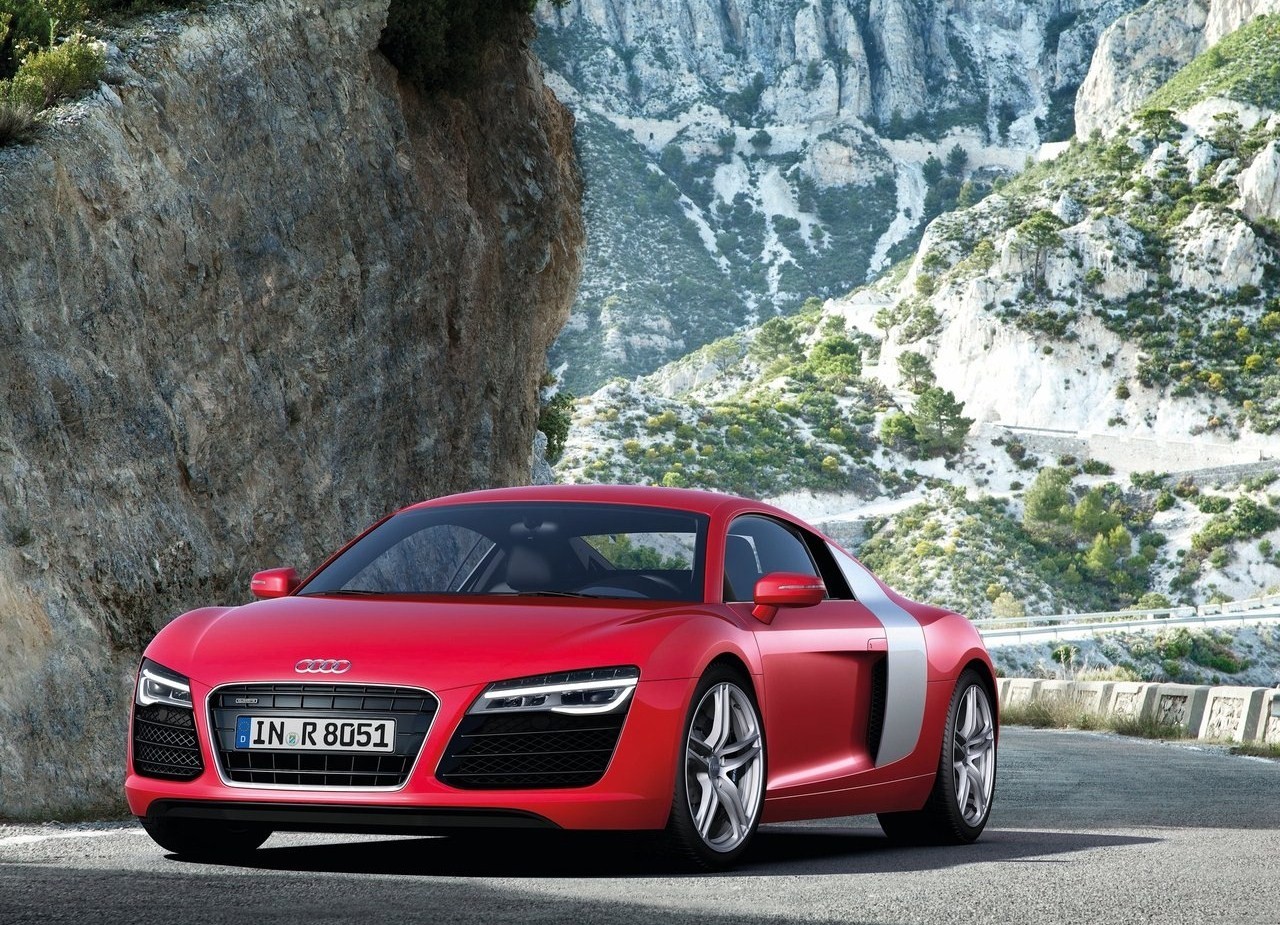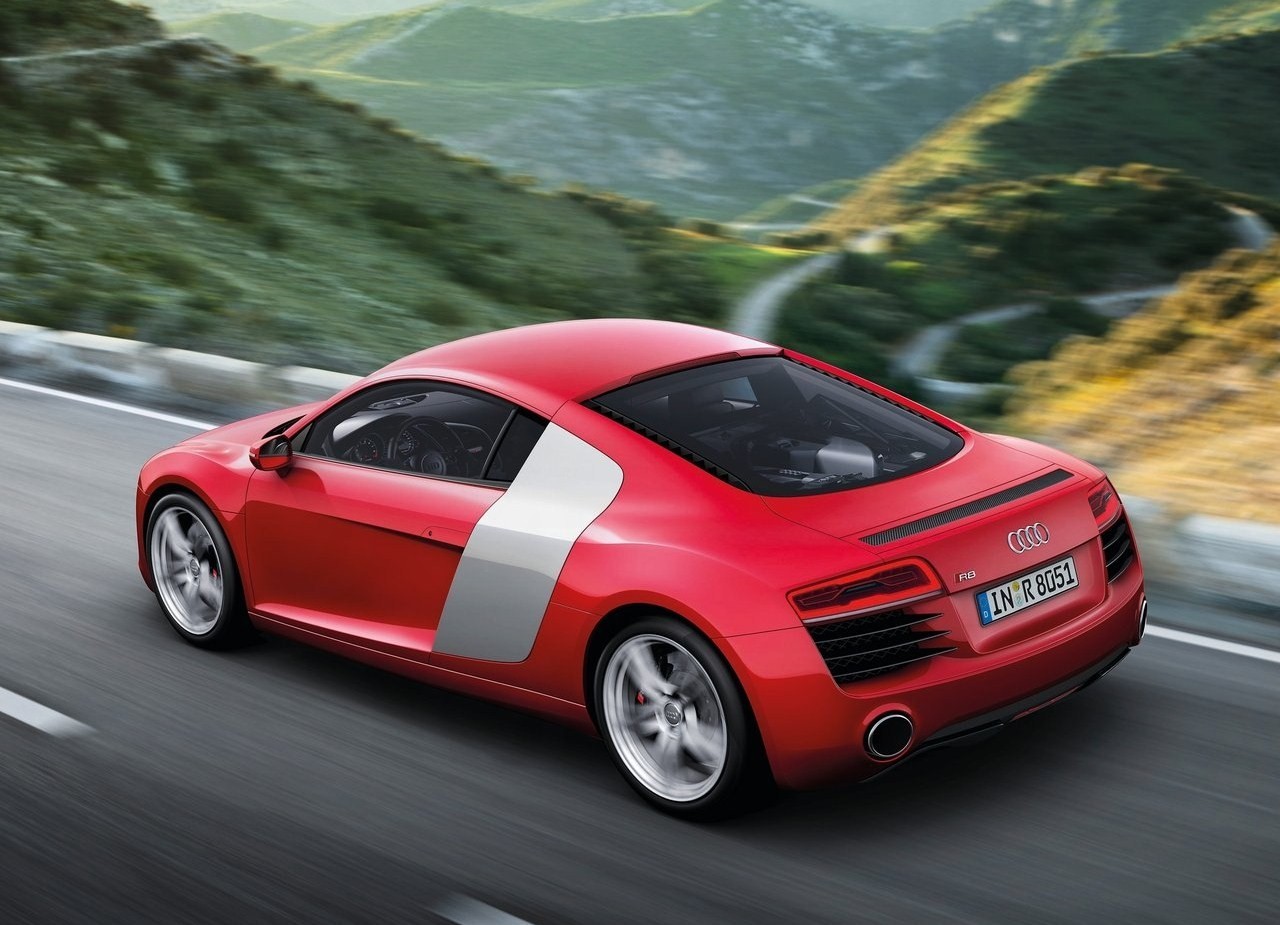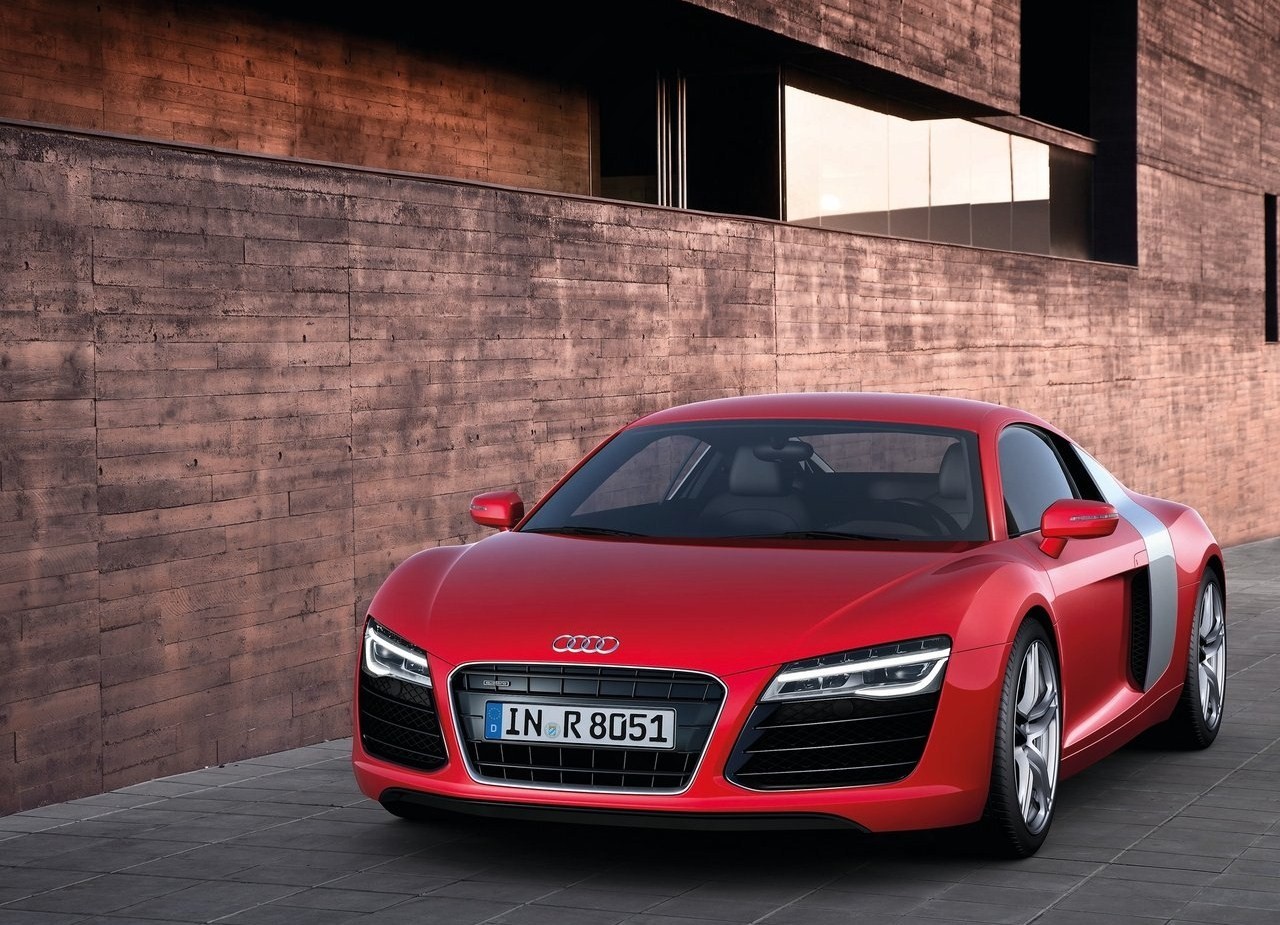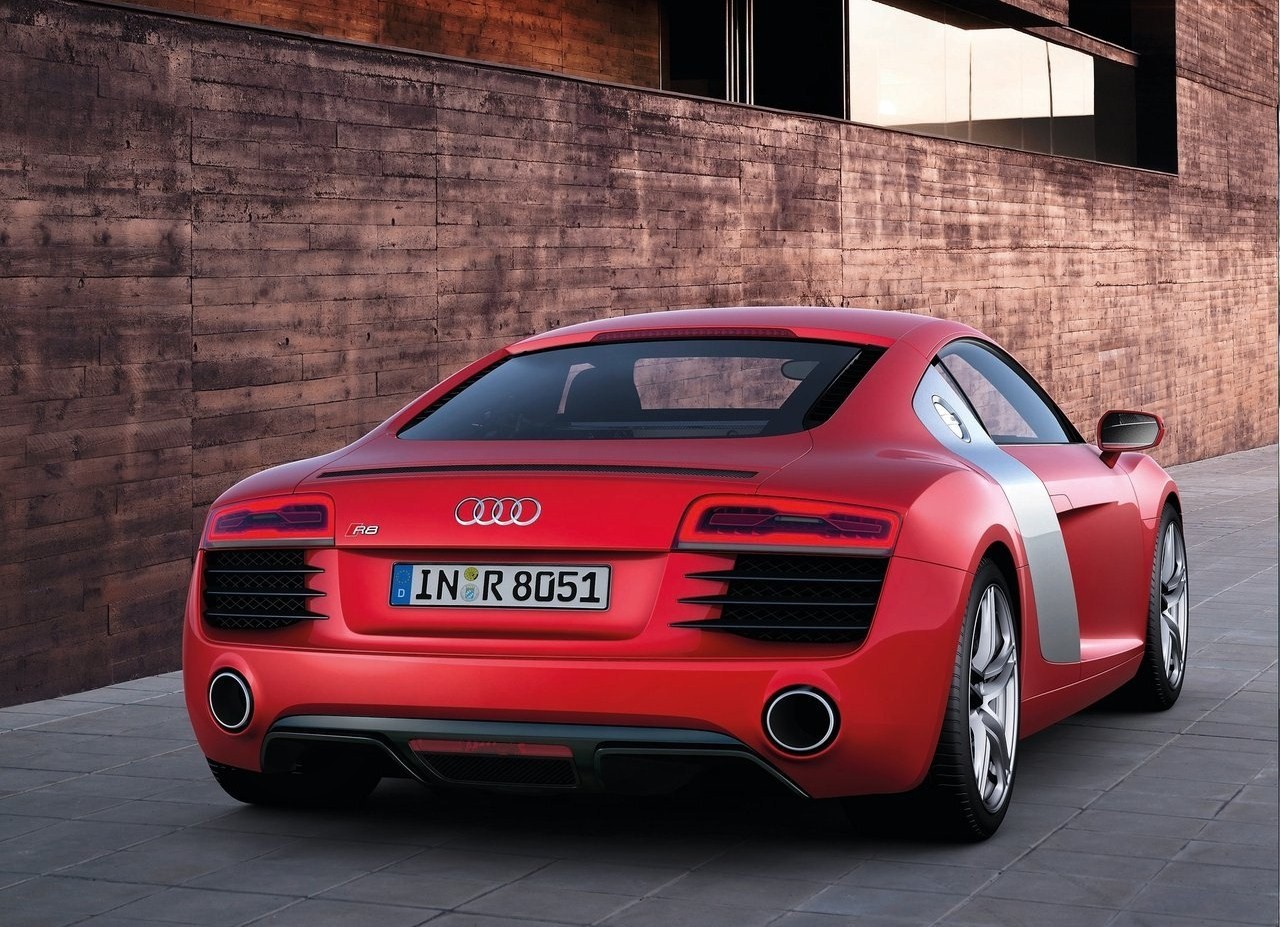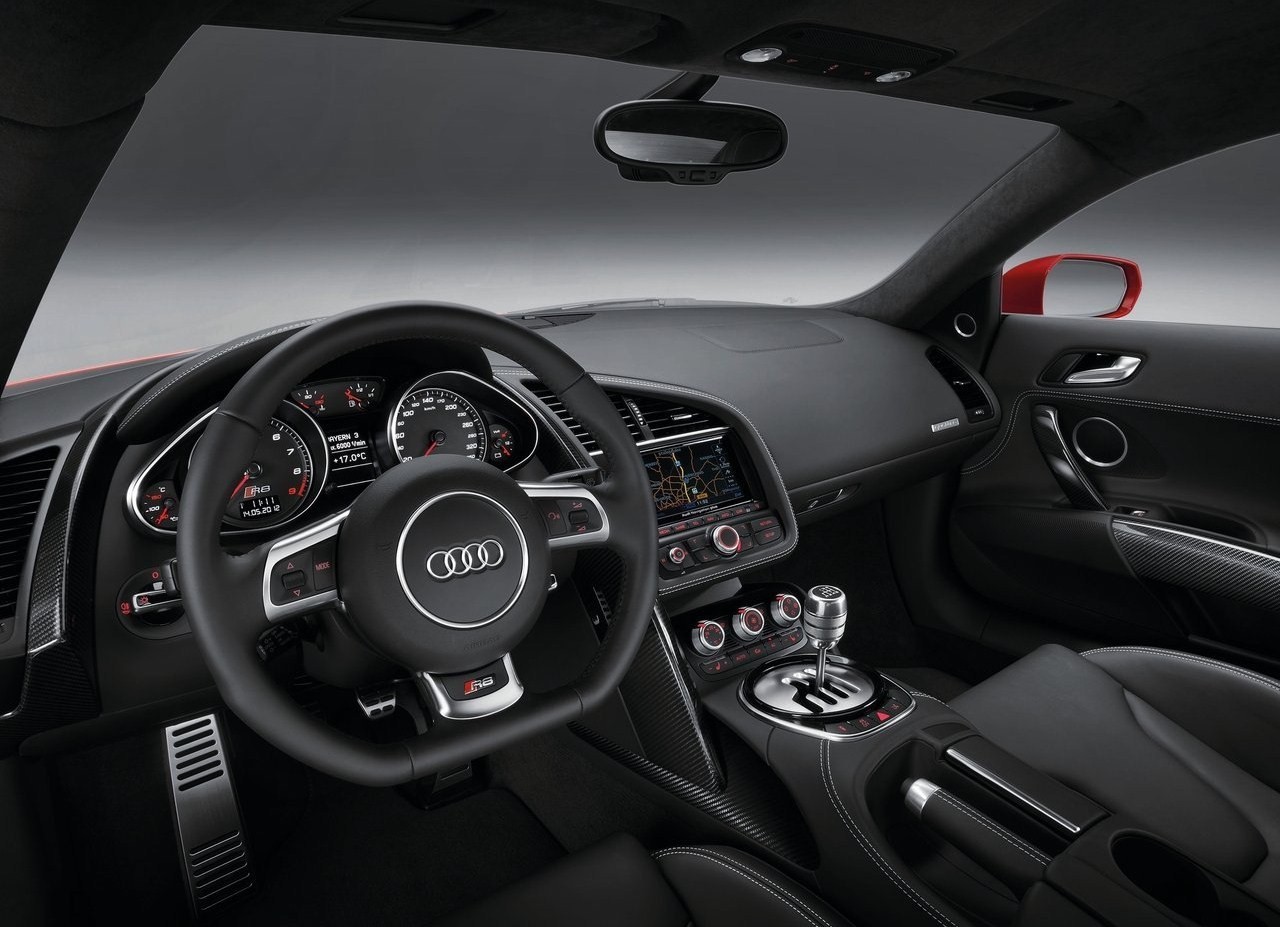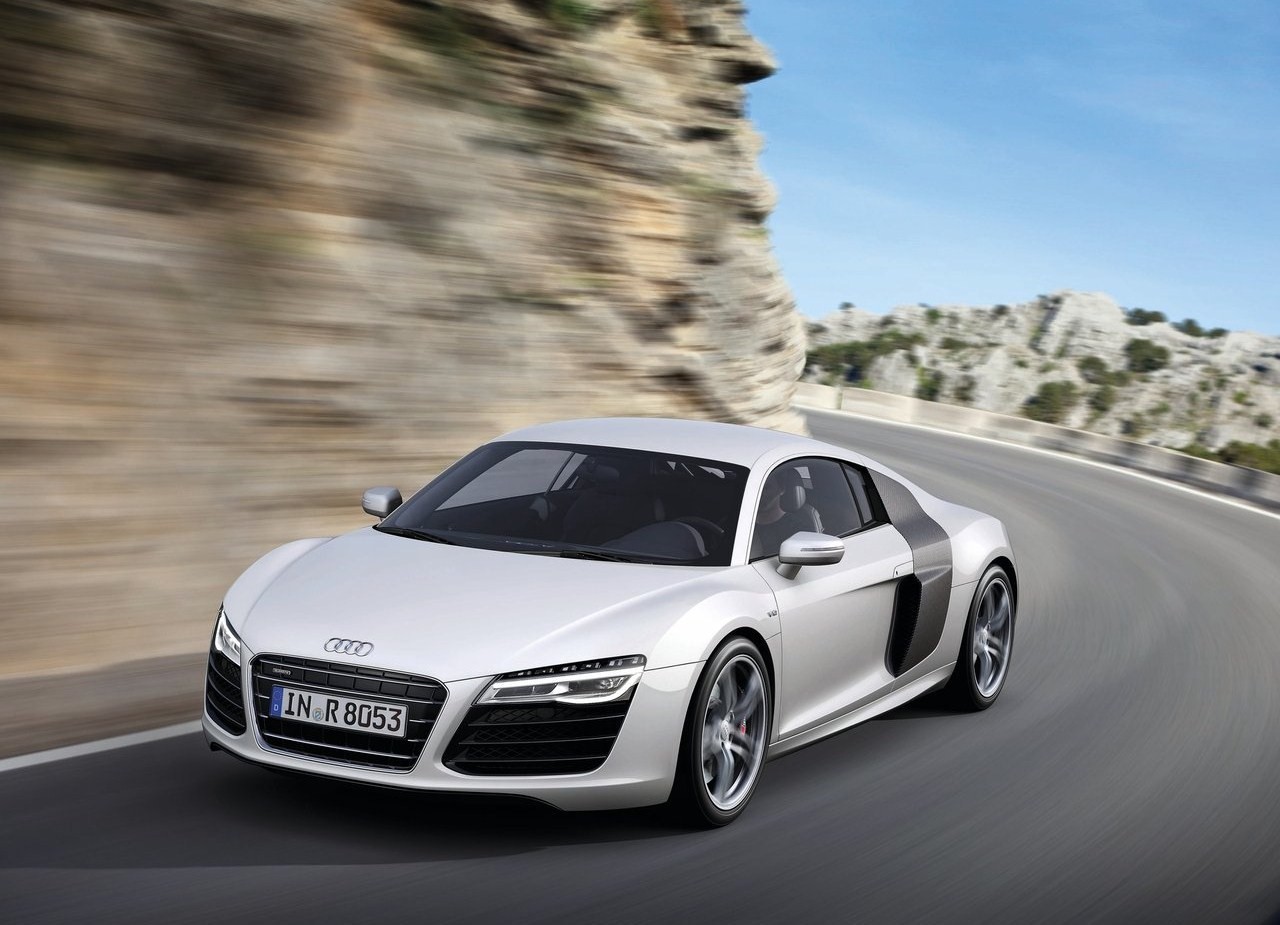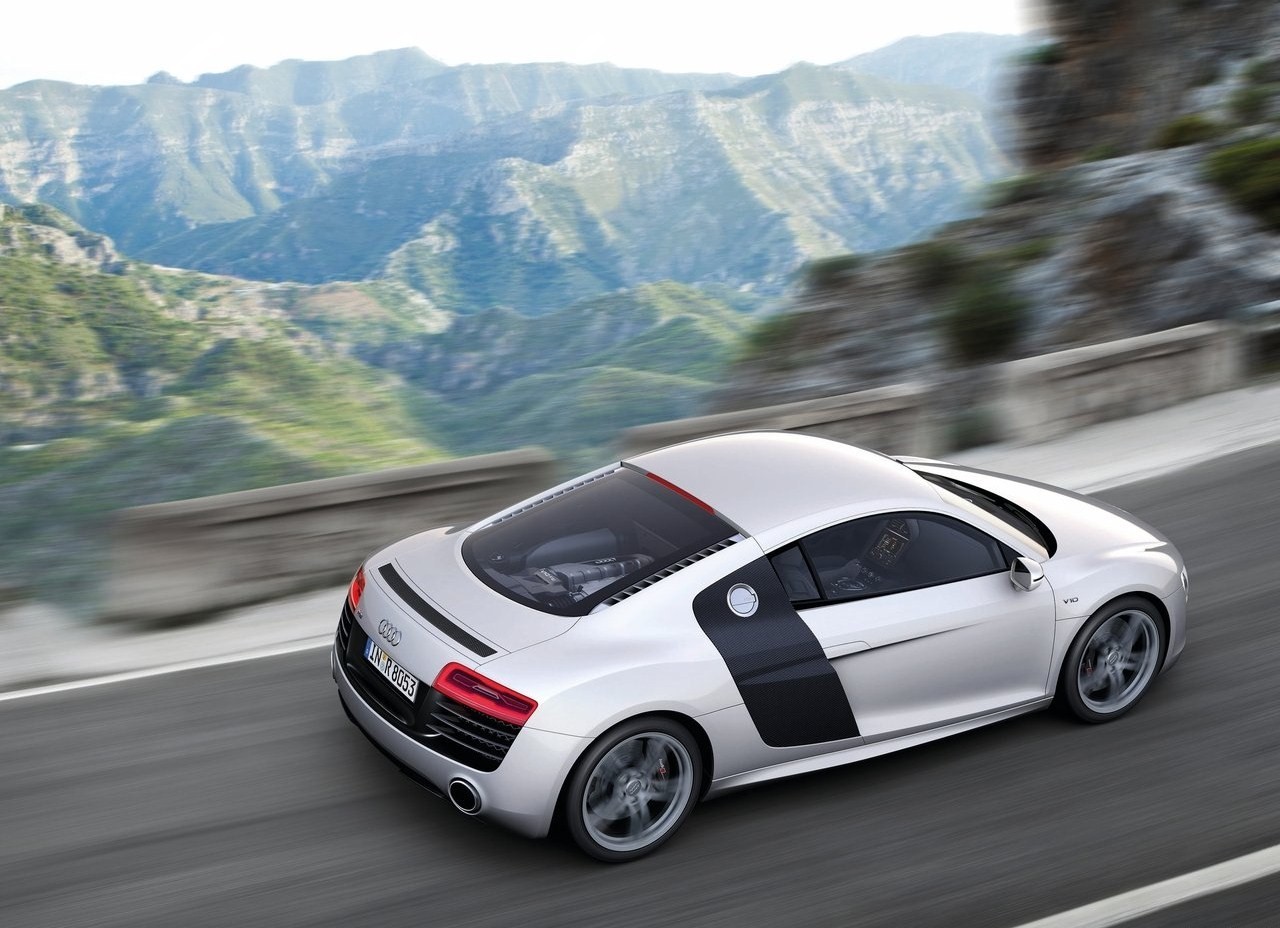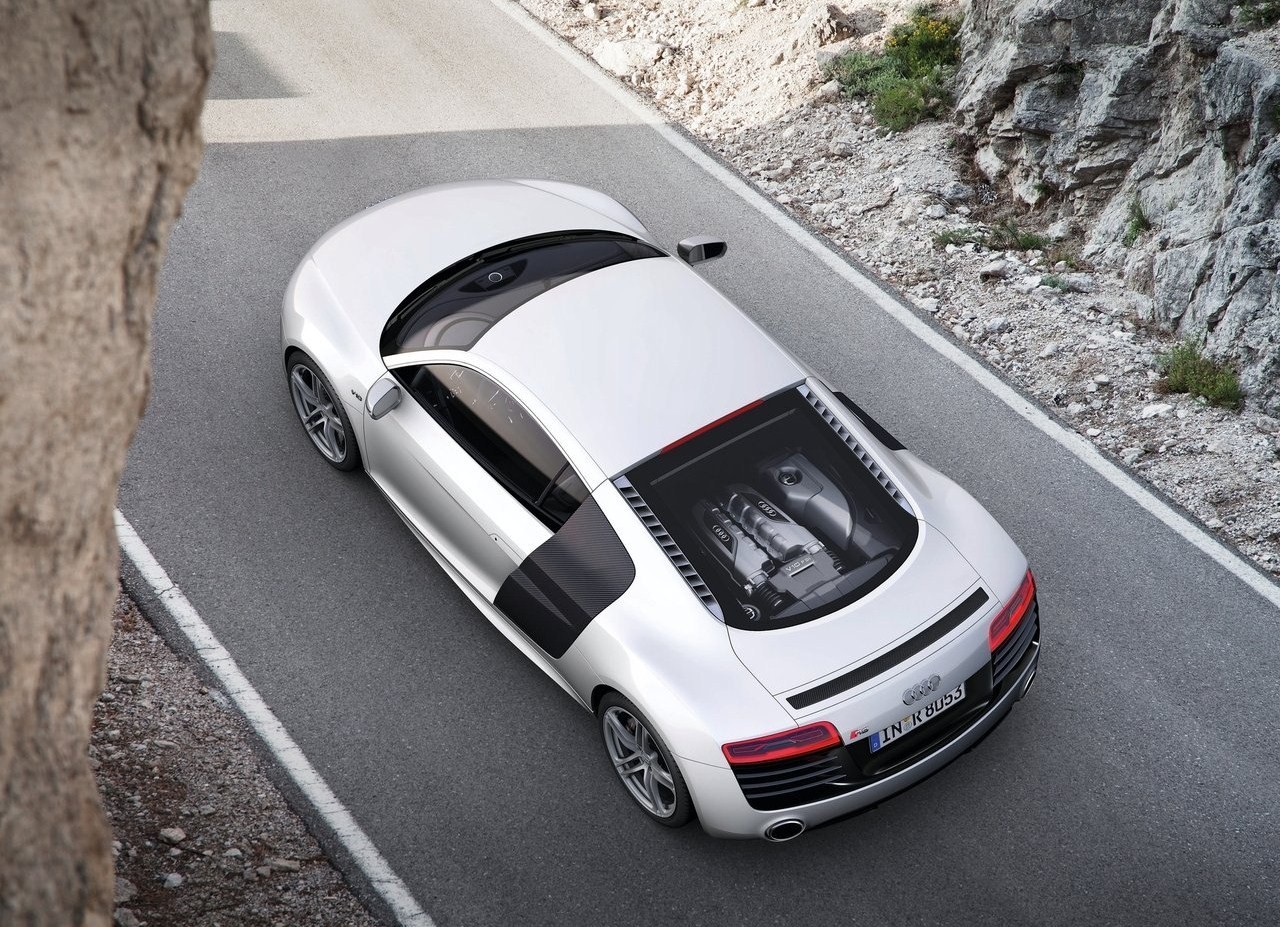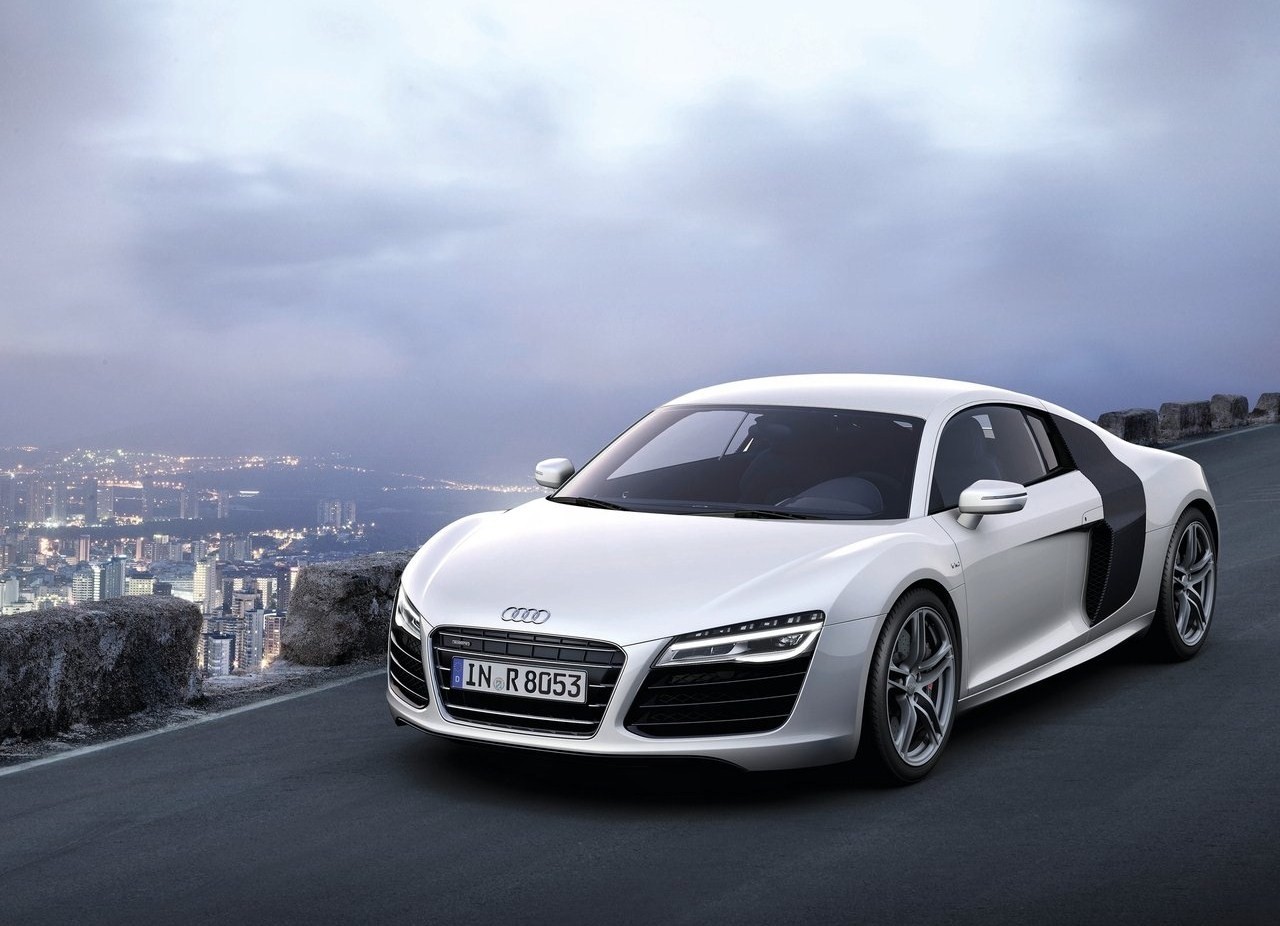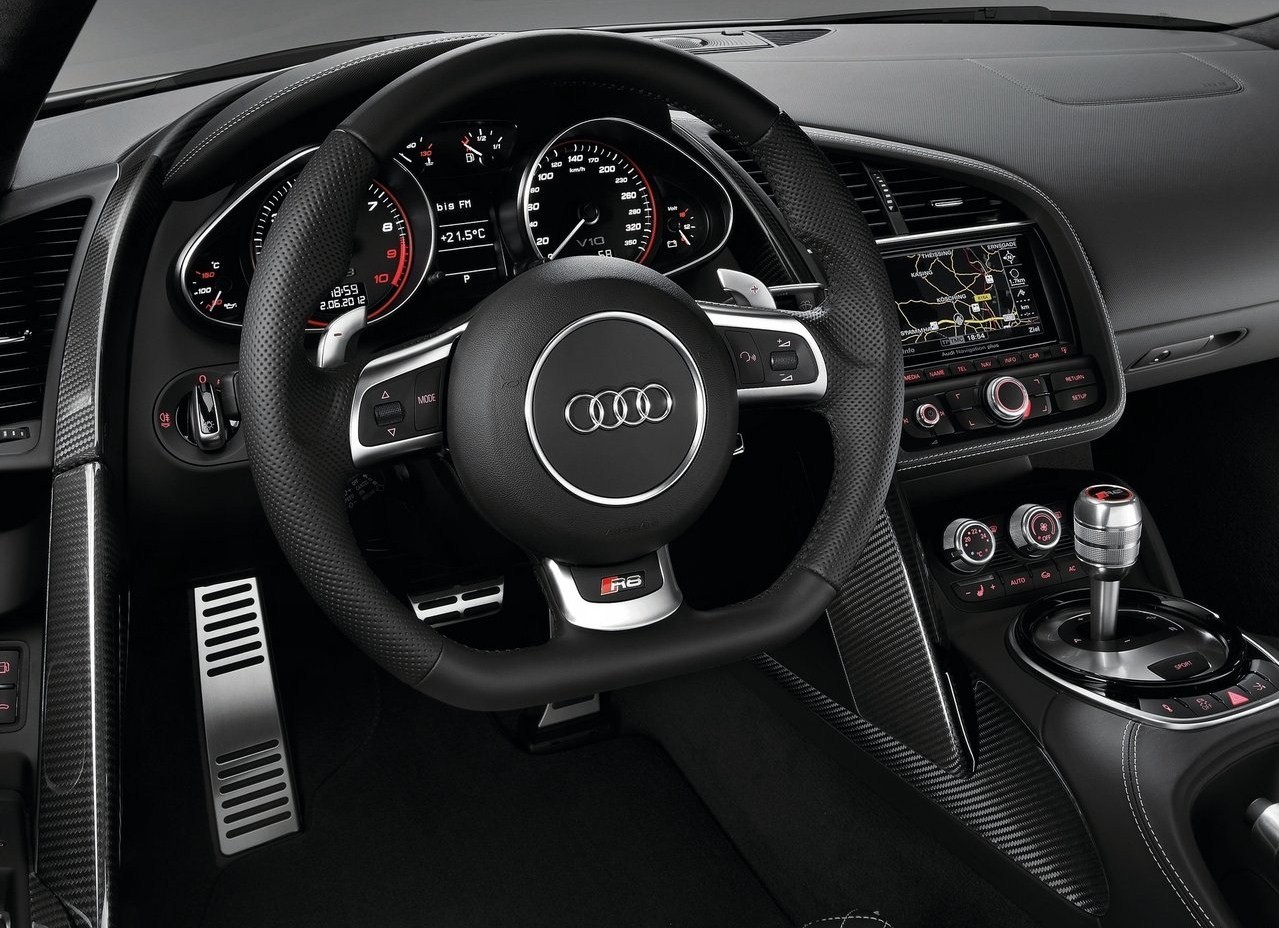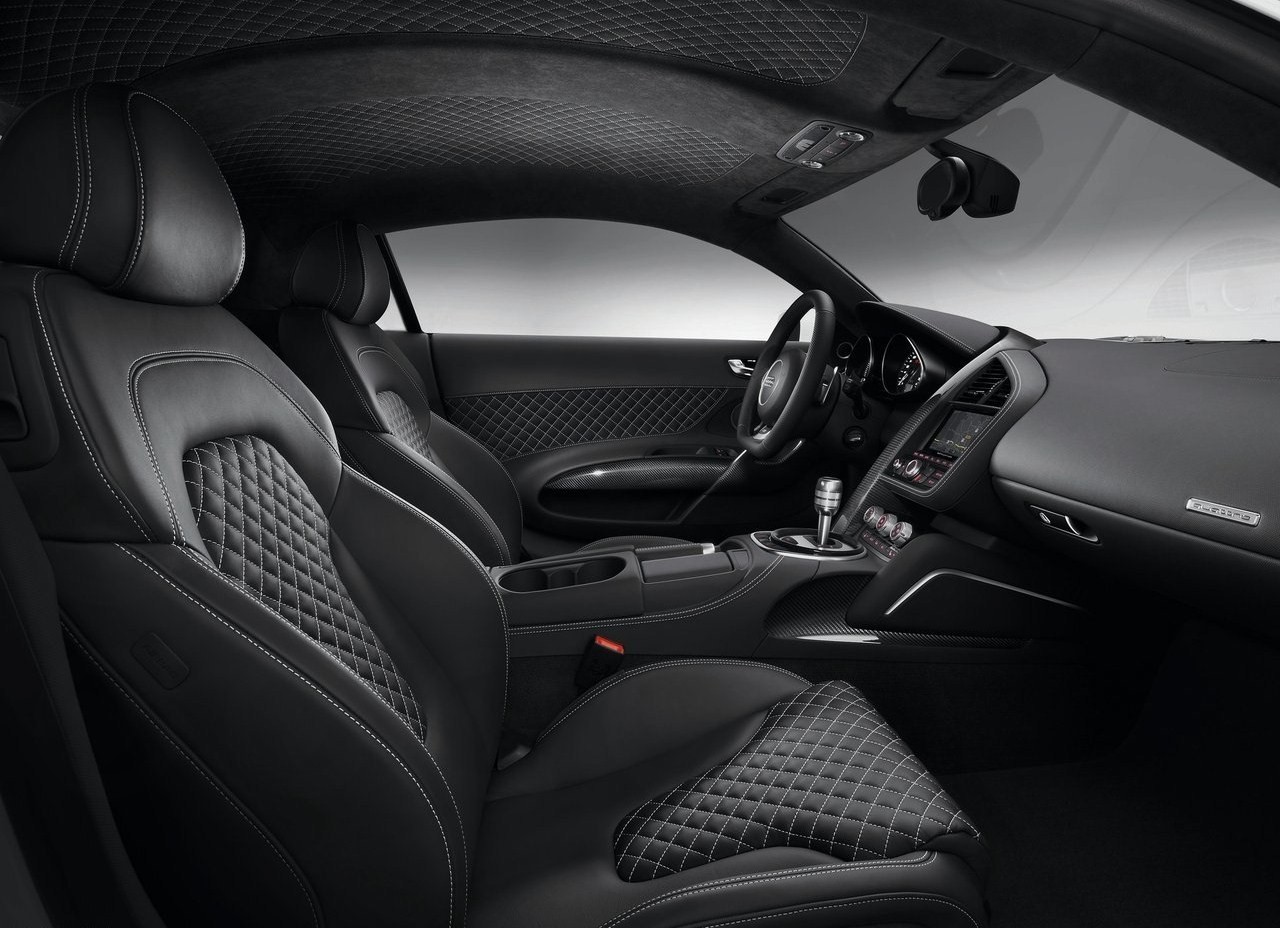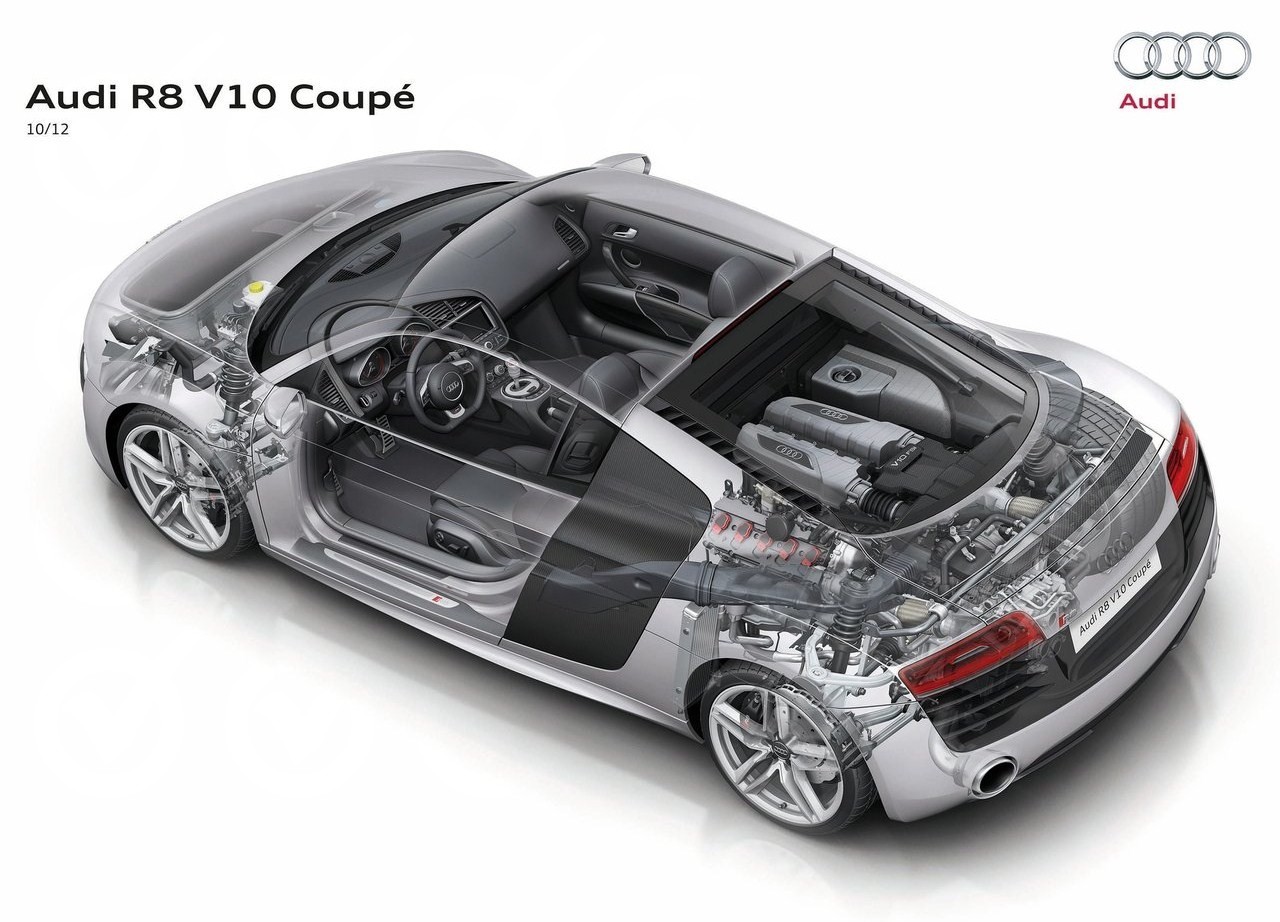
- Free-revving engines
- Traction from quattro system contributes to excellent dynamics
- S-Tronic transmission provides fast gearshifts
- For a supercar, surprisingly easy to drive
- Jerky R-Tronic transmission
- Slow steering ratio
- Driving experience lacks feedback of Porsche 997 911 Coupe
- Reports of carbon deposits on intake valves for 4.2 FSI engine
Review: Audi R8 (2007-12)
Overview
Released in September 2007, the Audi R8 was a mid-engined, high performance coupe (the R8 Spyder has been reviewed separately). Manufactured in Neckarsulm, Germany, the R8 was initially available with a 4.2-litre V8 petrol engine, mated to either a six-speed manual or semi-automatic sequential transmission (Audi’s ‘R-Tronic’). In August 2009, however, the R8 range was expanded with the introduction of V10 variants, powered by 5.2-litre V10 engines (shared with the Lamborghini Gallardo LP560-4). In September 2010, the V8 variants benefited from a slight power increase.
4.2 FSI and 5.2 FSI V8 engines
Both the 4.2- and 5.2-litre engines featured direct injection, double overhead camshafts per cylinder bank, four valves per cylinder, continuous variable valve timing for intake and exhaust camshafts and had compression ratios of 12.5:1.
Body and dimensions
The R8 was developed by Audi AG’s high performance subsidiary, quattro GmbH, and based on the Lamborghini Gallardo platform. As such, the R8 had an aluminium monocoque chassis which used space frame construction principles such that the bodyshell weighed only 210 kg. Compared to the Gallardo, the R8 was 86 mm longer (at 4431 mm), 4 mm wider (1904 mm), 87 mm taller (1252 mm) and had a 90 mm longer wheelbase (2650 mm).
Suspension
The R8 had double wishbone front and rear suspension and was fitted with Audi’s ‘Magnetic Ride Control’ system whereby the dampers were filled with magnetorheological fluid and the application of a magnetic field could vary the suspension’s resistance.
| Variant | Engine | Trans. | Years | Peak power | Peak torque |
|---|---|---|---|---|---|
| V8 | 4.2-litre BYH petrol V8 | 6sp semi-auto, 6sp man. |
2007-10 | 309 kW at 7800 rpm | 430 Nm at 5500 rpm |
| 4.2-litre CNDA petrol V8 | 6sp semi-auto, 6sp man. |
2010-12 | 316 kW at 7900 rpm | 430 Nm at 4500-6000 rpm | |
| V10 | 5.2-litre BUJ petrol V10 | 6sp semi-auto, 6sp man. |
2009-12 | 386 kW at 8000 rpm | 530 Nm at 6500 rpm |
| GT | 5.2-litre CMP petrol V10 | 6sp semi-auto, 6sp man. |
2010 | 412 kW at 8000 rpm | 540 Nm at 6500 rpm |
quattro
The R8’s ‘quattro’ all-wheel drive system consisted of a viscous coupling in the front axle housing. In normal conditions, the front:rear torque split was 15:85, but up to 35 per cent of the engine’s torque could be directed to the front axle if required. The R8 was also fitted with a rear electronic differential lock.
Safety equipment
Standard safety equipment for the Audi R8 included dual front airbags, front side airbags, ABS, electronic brake force distribution, brake assist, electronic stability control and traction control.
Brakes
The Audi R8 had ventilated and perforated 380 mm front discs with eight-piston calipers and 356 mm rear discs with four-piston rear calipers
Features
Standard features for the Audi R8 included 19-inch alloy wheels with 235/35 front and 295/30 rear tyres, Multi Media Interface (Audi’s ‘MMI’) with a 6.5-inch colour display, seven speaker 140 watt stereo with a six stack CD player, satellite navigation system and reversing camera, climate control air conditioning, leather seats with alcantara trim, power adjustable seats, cruise control, bi-xenon headlights with LED driving lights, Bluetooth connectivity, reverse parking sensors, automatic headlights, rain-sensing wipers, a leather-wrapped steering wheel, remote central locking with proximity key, power windows and heated mirrors, tilt and telescopic steering wheel adjustment, an electrochromatic rear view mirror, trip computer, an alarm and immobiliser. Models with the R-Tronic transmission were also fitted with steering wheel gearshift paddles.
The Audi R8 5.2 FSI variants added a twelve speaker, 465 watt Bang & Olufsen stereo with a ten-channel amplifier, Fine Nappa leather upholstery, heated seats and LED headlights (i.e. complete headlight units).
Audi R8 GT
In late 2010, five R8 GT models were imported to Australia. Compared to the 5.2 FSI, the GT’s engine achieved peak power and torque increases of 26 kW and 10 Nm and its kerb weight was reduced by 100kg. Visually, the GT could be identified by its red brake calipers, fixed rear wing, front bumper-mounted winglets, matte carbon side blades and GT badges. Inside, the GT featured bucket seats with a chassis of glass-reinforced plastic.
Audi R8 Carbon Edition
In December 2011, the R8 Carbon Edition was released. Compared to the standard R8s, the Carbon Edition was fitted with carbon-fibre ‘side blade’ air scoops, door mirrors, front lip spoiler, rear diffuser and illuminated sill plates. The Carbon Edition was also distinguished by its titanium-finished 19-inch double-spoke alloy wheels and gloss black grille and matte-black window surrounds.
Related links
- Specifications: Audi R8 Coupe (April 2007)
- Press Kit: Audi R8 5.2 FSI quattro (August 2008)
- Specifications: Audi R8 5.2 FSI quattro (August 2008)
- Specifications: Audi R8 Coupe (August 2009)
Review: Audi R8 (2013-15)
Overview
Released in March 2013, the 2013 R8 introduced a range-topping ‘V10 plus’ variant and seven-speed double-clutch transmissions (Audi’s ‘S-Tronic’). Visually, the 2013 R8 could be identified by its standard LED headlights, new rear indicator lights, single frame grille with beveled upper corners (and painted high-gloss black) and new front bumper. The V10 plus models were also fitted with a front splitter, mirror housings and side blades which were made of carbon fibre reinforced plastic.
The seven-speed double-clutch transmission utilised two multi-plate clutches – positioned behind one another – which served two mutually independent sub-transmissions. As a result, gears were shifted directly as the clutches alternately opened and closed. Unlike the V8 and V10 variants, the V10 plus was not fitted with Magnetic Ride Control instead having specially configured conventional springs and dampers.
| Variant | Engine | Trans. | Years | Peak power | Peak torque |
|---|---|---|---|---|---|
| V8 | 4.2-litre CNDA petrol V8 | 6sp man., 7sp DCT |
2013-15 | 316 kW at 7900 rpm | 430 Nm at 4500-6000 rpm |
| V10 | 5.2-litre BUJ petrol V10 | 7sp DCT | 2013-15 | 386 kW at 8000 rpm | 530 Nm at 6500 rpm |
| V10 plus | 5.2-litre CTP/CTY petrol V10 | 7sp DCT | 2013-15 | 404 kW at 8000 rpm | 540 Nm at 6500 rpm |
| LMX | 5.2-litre CTP/CTY petrol V10 | 7sp DCT | 2014 | 419 kW at 8000 rpm | 540 Nm at 6500 rpm |
Safety equipment
Compared to its predecessor, standard safety equipment for the 2013 R8 was unchanged.
Brakes
The Audi R8 V10 plus was fitted with 380 mm carbon-ceramic front brake discs with six-piston monoblock calipers and 360 mm carbon-ceramic rear brake discs with four-piston fixed calipers.
Features
Standard features for the R8 were extended to include LED headlights and Fine Nappa leather upholstery. The V10 plus variant was distinguished by its titanium-finished 19-inch alloy wheels, unique bucket seats with fibreglass frames, additional leather trim and Alcantara headlining.
Audi R8 V10 LMX
Released in Australia in August 2014, worldwide production of the R8 LMX was limited to ninety nine (99) vehicles. For the R8 LMX, each headlight had one laser module which comprised four high-power laser diodes. With a diameter of 300 micrometres, the diodes produced a blue laser beam with a wavelength of 450 nanometres; a phosphor converter then transformed this laser into roadworthy white light with a colour temperature of 5500 Kelvin. The laser spot – active at speeds of 60 km/h and above – supplemented the LED high beams in the R8 LMX for improved visibility. A camera-based sensor could detect other road users and adjust the light pattern to exclude them.
The R8 LMX also had carbon-fibre ceramic brake discs, a large fixed rear spoiler and an ‘Ara Blue’ crystal-effect paint finish.
Related links
